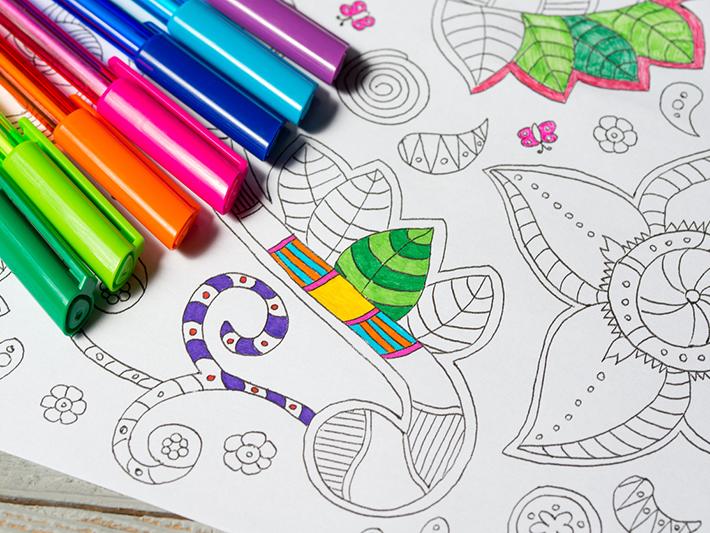
Colouring in: a big-impact, low-budget support for student well-being
Sit, slow down and colour. It’s such a simple activity, but for many students, colouring in is a powerful way to ease stress and improve mental well-being. In public areas, libraries or private spaces, students can take the time to fill blank spaces with coloured pens or pencils, and let the repetitive motion and creativity calm their minds.
University life brings distinct stresses, and higher education professionals are always looking for affordable, effective ways to support students’ mental health and build resilience. Research has shown that mindfulness-based activities, even short ones, can help reduce stress and improve well-being. New findings suggest that colouring could make a surprisingly positive impact on students’ mental health. Here’s how.
Why colouring?
Mindful colouring is an easy-to-apply activity that requires no special skills or experience. All that is needed are simple designs on paper, coloured pencils, a suitable space and time. Colouring helps students focus on the present moment and provides a break from the mental pressures of academic life. Guided mindful colouring has been shown to boost mental well-being and, according to studies, is as effective as breathing exercises. It is also a useful alternative for students who find meditation and other mindful activities challenging.
Even in self-guided, unstructured settings, colouring can have positive impacts on students’ overall mental health, recent research has found.
How colouring reduces student stress
Our recent study explored a two-week colouring intervention with 140 university students, each asked to engage in at least 10 minutes of self-guided colouring six times over the two-week period. Students were recruited through adverts and completed initial online well-being questionnaires. After signing up, they were instructed to find a quiet, comfortable space and spend at least 10 minutes colouring. At the end of the two-week study, they reported their colouring activity and completed more questionnaires.
- Resources on supporting well-being in higher education
- How can we help students manage frustration and build resilience?
- THE podcast: how can universities ensure students are safe and supported?
Unlike previous studies, this research asked students to fit colouring into their routine independently, following simple instructions, rather than attending scheduled sessions with mindfulness professionals.
The results were clear: students who completed at least six colouring sessions reported significant improvements in stress, anxiety, depression, overall quality of life and self-reported dispositional mindfulness.
Importantly, students enjoyed the activity, and most wanted to continue regular colouring after the end of the study.
Diversity in provision
One of the most valuable aspects of colouring as a mental health support tool is its universal appeal. Unlike some interventions that may require specific skills, training or even comfort with self-reflection, colouring is available for everyone, regardless of their previous experience with creative activities. In fact, the enjoyment of colouring comes from its simplicity and flexibility, making it an ideal resource for students from a diverse range of backgrounds and preferences.
Colouring resources can be easily adapted to reflect personal interests, cultural themes and even sensory needs. The wide variety of patterns and designs available – from mandalas to nature scenes to abstract patterns – allows students to choose options that feel most engaging and meaningful to them. In our study we shared mandala patterns, but students had the choice of these or their own materials, and most used a mixture of both.
Culturally relevant designs can help students find personal connection to their well-being practices and make their colouring a more affirming experience, while a choice of colouring tools – such as crayons, pencils or pens – may provide different sensory experiences. Our research is investigating the possible benefits of digital colouring using the same study design, potentially opening up more possibilities for this activity.
Why colouring could work for your campus
This study suggests that a small but regular commitment to colouring can foster better mental health among students – and it is about as low-cost and accessible as it gets. For universities, incorporating mindful colouring into student support resources can be straightforward. Providing students with instructions, along with downloadable colouring sheets or setting up a quiet space with colouring supplies in the library, well-being support or common areas could make a meaningful difference to student well-being.
This simple resource can also be signposted in settings such as academic tutor meetings and student workshops to demonstrate the benefits as part of a healthy work-life balance. Whether guided or not, even one short session of colouring can improve well-being and reduce anxiety, according to research, meaning this could be a useful activity to suggest in acutely stressful times such as waiting for well-being support or during exams.
Better yet, results are not limited to students. Colouring has been shown to reduce feelings of burnout and stress in teachers, and it supported hospital staff during the Covid-19 pandemic to manage stress, meaning colouring can support students and staff working in higher education.
Emma Palmer-Cooper is a lecturer in psychology in the School of Psychology at the University of Southampton.
If you would like advice and insight from academics and university staff delivered direct to your inbox each week, sign up for the Campus newsletter.




